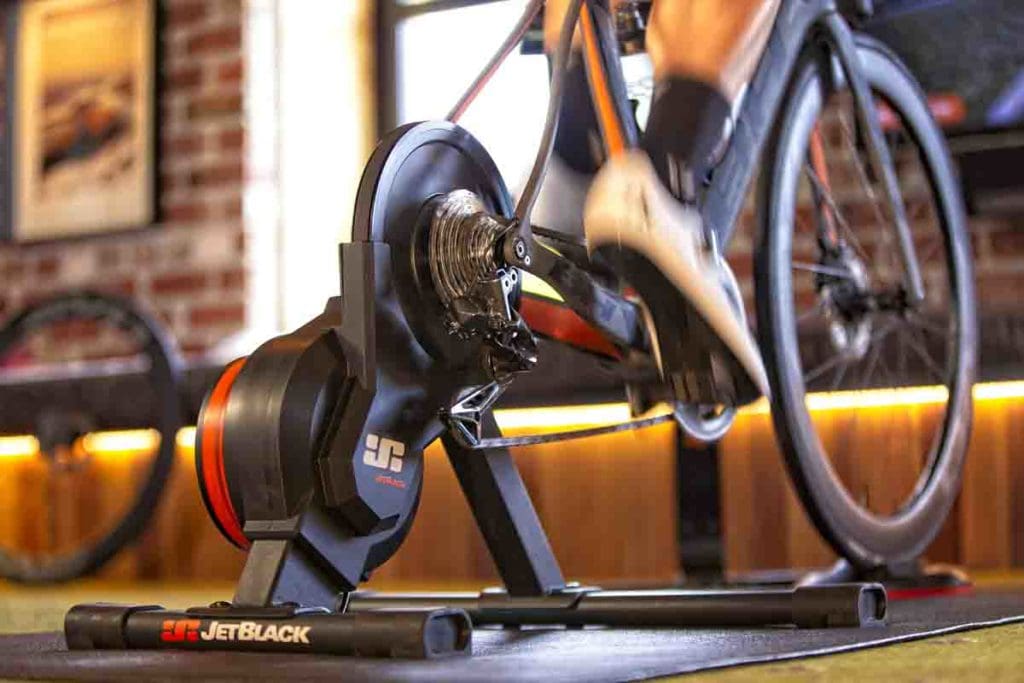JetBlack’s Zwift Rise to Global Coming of Age

Sydney, NSW
Indoor trainer manufacturer JetBlack has “come of age” as it signed a deal to supply its latest smart trainer model to the world’s largest online cycle training system, Zwift.
The two companies announced last week that Zwift would be rebadging the new JetBlack Volt V2, to sell as a Zwift trainer in the US, UK and Europe from 3rd October.
JetBlack founder and managing director Tony Simmonds describes the alliance as a “global coming of age” for his Sydney-based company and one of its greatest achievements.
“The real benefit to them was we’ve already done six years of development of our firmware.”
“Having the biggest cycling platform in the world aligned to our small Australian company, our technology and hardware is a great honour,” Tony said.
“It’s what we’ve dreamed of doing all these years.
“We know they’ve done their research into all sorts of different trainers. It’s huge kudos they ultimately came to us last December to use our product – firmware and engineering developed by our five-man team.
“Zwift has hundreds of employees and arguably they could have got there themselves, working on higher-end hardware but the real benefit to them was we’ve already done six years of development of our firmware.”
Earlier this year, news emerged that Zwift was developing its own turbo trainer, in conjunction with a real-world smart bike version of its in-game ‘Tron Bike’.
However, it issued a statement in May to say the project had been put on hold, and 150 jobs cut, because of “the current macroeconomic environment” as the Covid cycling boom eased and fewer people were taking up indoor cycling.
Tony said the Zwift CEO had first approached JetBlack last December and the two companies had been working together since then.
The Volt V2’s specifications compare well against the best smart trainers on the market, providing a maximum resistance of 1800 watts and power measurements accurate to within 2.5%. It can simulate gradient up to 16%, with a 4.7kg flywheel, and has a maximum rider weight of 130kg.
Focus on Ride Feel
However, Tony said riding feel was the key factor that set the Volt V2 apart from the competition.
“Our firmware was developed by riders, so all the nuances of riding, and ride feel – such as climbing and cresting over hills – was highly attractive,” he explained.
“There’s no doubt that Zwift Hub is going to disrupt the market, and we think that’s great news for the customer.”
“We’re seeing more and more smart trainers, including more OEM type trainers at cheaper price points coming out of Asia, but the downside of those units is the ride feel. They will compare things like maximum watts or power accuracy but to the average rider there’s a lot more to trainer performance than pure numbers.
“Our small team was able to hone in on the things that are important to good ride feel and we’ve been chipping away at that for six years.”
Zwift announced this month its Hub indoor trainer will sell direct to consumers in the US, UK and Europe for $499 US (A$729), £449 and €499, well below comparable trainers.
“There’s no doubt that Zwift Hub is going to disrupt the market, and we think that’s great news for the customer,” Zwift CEO and co-founder Eric Min said.
While the Zwift platform is compatible with other smart trainers, he conceded getting set up on the Zwift platform “hasn’t been an easy process”. However, it would be simpler with the Hub which, to add to its ready-to-ride status will be shipped with a cassette already installed.
The Hub won’t be available for sale in Australia but JetBlack will sell the same unit as the JetBlack Volt V2 for $799 in this country and will have it available in other markets.
The company has established a direct-to-consumer website but still operates primarily through retailers.
This month’s release of the Volt V2 will be followed soon after by a series of JetBlack indoor training accessories, including a steering mechanism also due to be launched in September.
Tony said while the pricing of the Volt V2 and Hub will put great pressure on a trainer industry accustomed to much larger sales margins, it will also make them financially accessible for a larger audience and open the door for the sale of accessories with larger margins.
JetBlack recently released a television stand with easily adjusted heights, to join its smart trainer table, rocker plate and a pivoting riser block.
The company’s smart turn block is poised for release “once it’s integrated into the Zwift game, which hopefully will be within the next week or two”.
A trainer tray designed to fit to handlebars is expected to be available before Christmas and a fan specifically design for indoor training is “the last piece of the puzzle”, slated for release just before Christmas or early in the new year.
“We would have liked to go to market sooner with the V2 and accessories but Covid and manufacturing costs put hurdles in the way,” he said.
“However, as factory capacity caught up, we’ve been able to hit the kind of price points we wanted with those accessories.”

Boost For JetBlack Sales
Tony said while working with Zwift had brought a significant financial boost for his company, he is more excited about what the alliance will mean for JetBlack’s own sales.
“I’m hoping having Zwift using our Volt and the publicity that will generate will get Australians wanting to support a local company that has provided something to the world,” he said.
“Our association with Zwift is pushing us to heights we couldn’t dream of getting but the commercial aspect for us is people realising how good the trainer is.”
“It has been hard for us to compete against Wahoo and Tacx because those brands are so well known. That has been a frustration of mine. Our trainer is every bit as good as anyone else’s product and yet I still see people spending hundreds of dollars more for something that’s not Australian, just because all their friends have one.
“Hopefully this will make people think ‘if Zwift has chosen Jet Black why would we spend more money on anything else?’
“We’ve been licenced by Zwift to use their logo and certification on the packaging for the Volt and in our marketing. That’ll give the consumer a lot of confidence.
“In terms of global profile, our association with Zwift is pushing us to heights we couldn’t dream of getting but the commercial aspect for us is people realising how good the trainer is and going ‘hey there’s all these accessories that are equally as good and equally as affordable’.”
He said within two days of the Hub, Volt V2 and alliance announcements, his company was contacted by 15 retailers wanting to become JetBlack dealers, and he’s hopeful there will be many more.
While the Volt V2’s retail price continues the company’s history of price disruption, spanning back to the release of its first fluid trainer in 2005, the margins available through the accessories would benefit retailers.
“Zwift is prepared to make very little or almost no margin on the hub because if they can sell trainers at a cheap price, more people are going to buy trainers and they can gain revenue through subscriptions,” Tony said.
“It will be interesting to see on a global scale how the rest of the indoor training market reacts and how competitors are going to be able to compete at that sort of pricing level.
“We will be able to offer our retailers the ability to sell the JetBlack Volt and still make a margin on it that’s comparable with electronic goods and still have the whole raft of accessories they can make reasonable margins on. “
Ongoing Relationship
Tony said the relationship between Jet Black and Zwift is ongoing, including the soon-to-be-released smart steering software, using the smart turning block, to allow riders to turn left or right down different route options at intersections just by moving their handlebars.
“As soon as you’re in the game, you can turn your handlebars and navigate at intersections, without having to grab a remote control or use a keyboard,” he said.
“For someone like me who spends a lot of time on Zwift, that’s really exciting. We think it’s going to be the next frontier and can be adapted to virtual riding on off-road trails, which we’re starting to see with Zwift.”
The smart steering system could also be compatible with other platforms as their developers realise that cycling is “not just about turning the pedals but also steering and navigating your bike for the whole interaction”.
“Elite has a great product with its Sterzo but it’s spring operated and when you’re riding on the road you don’t have a spring pushing your handlebars straight,” he added.
“Our system is not spring loaded, it’s measured in degrees and, in my opinion, it provides a greater sense of realism.
“We are careful not to say our smart trainer system is like riding on the road because it’s not. I prefer to describe it as creating a huge level of engagement and making it a lot more realistic.
“We’re looking at how we can continue to make that same level of feel and performance in products with prices that are more accessible. We’ve got some other products we’re working on for certain price points.
“Since we started JetBlack in 2005, we’ve always had the vision to be a global brand. We’re very optimistic about what the future holds for us.”
